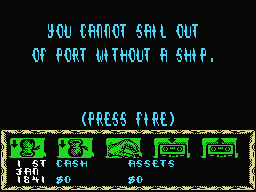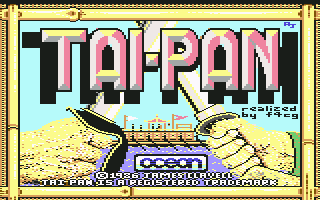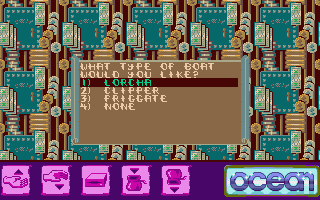Retro Replay Review
Gameplay
Tai-Pan casts you as an ambitious trader in 19th-century China, and your first task is to secure a loan to purchase your ship. This opening gambit immediately sets the tone: resource management and strategic decision-making are at the heart of the experience. You can recruit a crew by paying fair wages or take a more ruthless route and kidnap sailors off the streets. These early choices have real consequences, affecting morale, desertion rates, and even your reputation in port cities.
(HEY YOU!! We hope you enjoy! We try not to run ads. So basically, this is a very expensive hobby running this site. Please consider joining us for updates, forums, and more. Network w/ us to make some cash or friends while retro gaming, and you can win some free retro games for posting. Okay, carry on 👍)
Once your crew is assembled and your vessel purchased, the game shifts into its three distinct stages. The first phase unfolds on the bustling streets of colonial Hong Kong. You’ll negotiate deals, bribe officials, and hunt down stubborn characters who hold the key to unlocking better trading routes. The point-and-click interface for street navigation feels intuitive, but success demands careful attention to each character’s temperament and the prevailing social tides.
The second stage takes you out to sea, where wind direction, ship condition, and crew morale become critical. You chart courses between Shanghai, Manila, and other trading hubs, encountering random events like storms or pirate attacks. Boarding enemy vessels turns into a rough-and-tumble skirmish, requiring tactical use of your men and ship’s resources. This blend of open-ended trading and tactical combat ensures no two voyages feel exactly the same.
Finally, the third stage weaves your successes (or failures) back into the world of high finance. You’ll decide which exotic goods to stock—tea, silk, opium—and haggle fiercely on arrival. Profit margins fluctuate wildly based on supply, demand, and political developments. Balancing risk and reward here can make or break your fledgling trading empire, giving seasoned players a rewarding late-game puzzle.
Graphics
Tai-Pan’s visuals reflect its era, offering a mix of top-down pixel art for street scenes and side-view sprites for naval encounters. While the graphics won’t dazzle modern audiences, they possess a certain retro charm that faithfully evokes Victorian-era Hong Kong. Buildings, docks, and crew members are rendered with just enough detail to convey atmosphere without cluttering the screen.
The interface is predominantly text-driven, with clear menus for trading, crew management, and navigation. Icons are used sparingly to indicate your ship’s status and cargo hold, ensuring you’re never overwhelmed by flashy visuals. This minimalist approach prioritizes readability—crucial when you’re juggling multiple currencies, loan repayments, and crew loyalty at once.
Sea voyages feature simple yet effective waves, billowing sails, and enemy ship sprites that sail into view. Panning the camera across open water might feel static at times, but occasional weather effects and boarding animations add dynamism. If you’re looking for high-fidelity graphics, you’ll be disappointed—but if you appreciate functional art that serves gameplay, Tai-Pan delivers.
Story
Adapted from James Clavell’s novel, Tai-Pan drops you into the cutthroat world of international trade and colonial politics. While the game doesn’t attempt to retell the novel’s rich character arcs in full, it does capture the spirit of ambition and cultural collision that defines the original text. Your rise from penniless adventurer to venerable merchant mirrors Clavell’s themes of power, loyalty, and moral compromise.
Story beats are delivered via in-game events: letters from potential investors, unexpected inspections by the East India Company, or whispered rumors of rebellion in the streets. These narrative snippets provide flavor and often force you to rethink your strategy on the fly. Though there’s no branching dialogue tree, the emergent narrative created by your trading choices and encounters feels compelling in its own right.
Secondary characters—rival traders, colonial officials, and local fixers—add texture to your journey. Some will become allies if you repay debts on time; others will turn on you the moment you default. This web of relationships can lead to betrayals or windfalls that echo the political intrigue of 19th-century China, giving depth to what might otherwise be a purely economic simulator.
Overall Experience
Tai-Pan’s blend of strategic trade, street-level diplomacy, and naval combat offers a unique trip back to the heyday of text-and-pixel adventure games. Its learning curve is steep—newcomers may find the loan-mechanics and crew morale system bewildering at first—but once you grasp the rhythms of buying low, selling high, and keeping your men content, the game’s open-ended design becomes deeply satisfying.
The atmospheric setting, bolstered by period-appropriate music and sound effects, immerses you in a world of foggy harbors and lantern-lit alleyways. While modern titles may offer more cinematic flair, Tai-Pan’s minimalist presentation leaves room for your imagination to fill in the gaps, heightening the sense of discovery.
For players who relish trading sims, historical settings, or James Clavell’s storytelling, Tai-Pan remains a hidden gem. It may not hold your hand, but it rewards patience, strategic thinking, and a willingness to embrace its old-school charm. If you’re ready to carve out your own legacy and build a fortune on the high seas, Tai-Pan is an experience worth exploring.
 Retro Replay Retro Replay gaming reviews, news, emulation, geek stuff and more!
Retro Replay Retro Replay gaming reviews, news, emulation, geek stuff and more!









Reviews
There are no reviews yet.